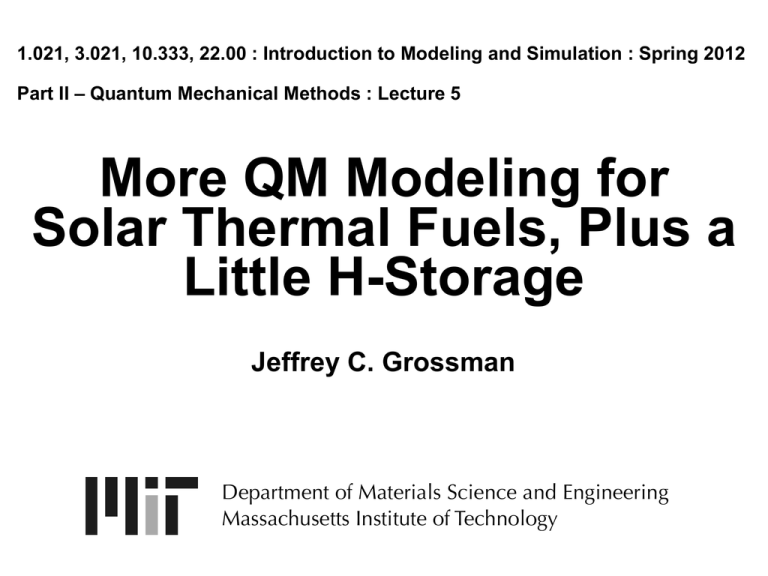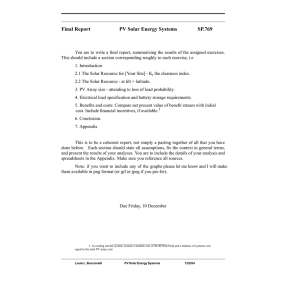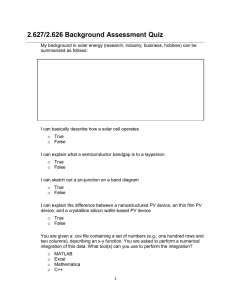
1.021, 3.021, 10.333, 22.00 : Introduction to Modeling and Simulation : Spring 2012
Part II – Quantum Mechanical Methods : Lecture 5
More QM Modeling for
Solar Thermal Fuels, Plus a
Little H-Storage
Jeffrey C. Grossman
Department of Materials Science and Engineering
Massachusetts Institute of Technology
Part II Topics
1.
2.
3.
4.
5.
6.
7.
8.
9.
10.
11.
It’s a Quantum World: The Theory of Quantum Mechanics
Quantum Mechanics: Practice Makes Perfect
From Many-Body to Single-Particle; Quantum Modeling of Molecules
Application of Quantum Modeling of Molecules: Solar Thermal Fuels
Application of Quantum Modeling of Molecules: Hydrogen Storage
From Atoms to Solids
Quantum Modeling of Solids: Basic Properties
Advanced Prop. of Materials: What else can we do?
Application of Quantum Modeling of Solids: Solar Cells Part I
Application of Quantum Modeling of Solids: Solar Cells Part II
Application of Quantum Modeling of Solids: Nanotechnology
Lesson outline
• Feeling good about energy levels
• Continued discussion of solar thermal
fuels
• Interactive calculations and discussion
on candidate fuels
• Hydrogen storage
Let’s look at a single element:
carbon
Nanotube architecture © John Hurt; graphene integrated circuit © Raghu Murali; other images © sources unknown. All rights reserved.
This content is excluded from our Creative Commons license. For more information, see http://ocw.mit.edu/help/faq-fair-use/.
Carbon in Energy to Date
One Barrel of oil
(159 liters) =
1.73 MWh of energy.
© sources unknown. All rights reserved. This content is excluded from our Creative Commons license. For more information, see http://ocw.mit.edu/help/faq-fair-use/.
Same C:
5
10
X Improvement
That same 1 barrel could be used to make the plas3c needed for thin-­‐film solar cells.
© sources unknown. All rights reserved. This content is excluded from our Creative
Commons license. For more information, see http://ocw.mit.edu/help/faq-fair-use/.
The solar cells could generate ~16,000 MWh of energy over their life;me, or 10,000 X as much. Energy Levels and
Basis Sets
Let’s pause and feel our oneness with these things.
Energy Levels
H (⇧
r ) = E (⇧
r)
The S. Eq. leads
to wavefunctions
Which squared lead to
probability distributions
Image adapted from Wikimedia Commons,
http://commons.wikimedia.org.
Which once
spin is taken
into account
Courtesy of David Manthey. Used with permission.
Source: http://www.orbitals.com/orb/orbtable.htm.
Tells us about
energy levels!
Energy Levels
Courtesy of Mark R. Leach on meta-synthesis.com.
http://www.meta-synthesis.com/webbook/39_diatomics/diatomics.html
Review: Basis functions
⇥=
Matrix eigenvalue equation:
H
⇥
ci
i
d⌥
r
jH
ci
i
expansion in
orthonormalized basis
functions
=E
i
i
=E
i
i
=E
H
ci
⇥i
Hji ci = Ecj
i
H⇤
c = E⇤
c
ci
i
d⌥
r
j
ci
i
i
Basis Set Convergence
When is a basis set converged?
• Many basis sets have been
made for different elements.*
• You can make your own one
too.
• This can lead to big tables
(but chemists love big tables!).
* see, e.g., bse.pnl.gov
Basis Set Convergence
© source unknown. All rights reserved. This content is excluded from our Creative Commons license. For more information, see http://ocw.mit.edu/help/faq-fair-use/.
What else?
After the basis set is converged, is
the calculation “right”?
example: what is the most stable structure of 20 carbon atoms?
Hmmmm....
© source unknown. All rights reserved. This content is excluded
from our Creative Commons license. For more information,
see http://ocw.mit.edu/help/faq-fair-use/.
Back to our first
application example: Solar
Chemical Fuels
Solar-Chemical :
Heat stored in chemical bonds
Charging
Old Idea,
BUT: rapid
degradation
for ALL
cases.
Heat
Discharging
A novel approach to solar
thermal fuels
'*' !$
#,,,
,,, #,
ν
Δ
@
ν
Δ
ν
@A
/&(
Δ
-*$,)*5,(@',)5($(
% # )
Role of the CNT template
Intermolecular Separa6on (A)
Rigid substrate – fixes inter-­‐molecular distances over long range, enabling:
§ steric inhibi:on
§ π-­‐stacking
§ hydrophobic interac:ons
Enables design of specific intermolecular interac:ons – not available in free azobenzene
New Materials for Solar
Thermal Fuels
ν
Δ
Δ
ν
ν
Δ
6
New Chemistry Platform
for Solar Thermal Fuels
5
!$#
So Why do We Need QM?
excited state
hν
Ea
ΔH
Solar radiation spectrum © Robert A. Rohde/Global Warming Art. License: CC-BY-SA. This content is excluded
from our Creative Commons license. For more information, see http://ocw.mit.edu/help/faq-fair-use/.
19
In-Class Calculations of
Solar Thermal Fuels
Key Concept: Density of
States (DOS)
20
From The Band Gap to
Storage Efficiency
• Assume that all photons that have higher energy than the
band gap get absorbed by the molecule AND lead to photoisomerization.
• Let the fraction of molecules in the excited state (cis state)
be x.
• Then, for a solar spectrum I(lamda):
Z max,cis
Z max,trans
x
I( )d = (1 x)
I( )d
0
0
max
=
hc
Ebandgap
From Absorption Spectra
to Storage Efficiency
• Assume that all absorbed photons lead to photoisomerization.
• Let the fraction of molecules in the excited state (cis state)
be x.
• Then, for a solar spectrum I(lamda):
Z
Z
I( )
I( )
x abscis ( ) hc d = (1 x) abstrans ( ) hc d
( )
( )
But how do we get this “abs” func/on?
-­‐-­‐> from the energy levels!!
Summary/Reading
• What is convergence in a Quantum Mechanical
Calculation?
• Feeling for what those energy levels mean!
• Connection of energy levels to light absorption,
and connection of that to charging efficiency in
solar fuels.
• Extra reading: google “atomic orbitals,” “molecular
orbital theory,” etc.
• A bit on hydrogen storage.
MIT OpenCourseWare
http://ocw.mit.edu
3.021J / 1.021J / 10.333J / 18.361J / 22.00J Introduction to Modelling and Simulation
Spring 2012
For information about citing these materials or our Terms of Use, visit: http://ocw.mit.edu/terms.



